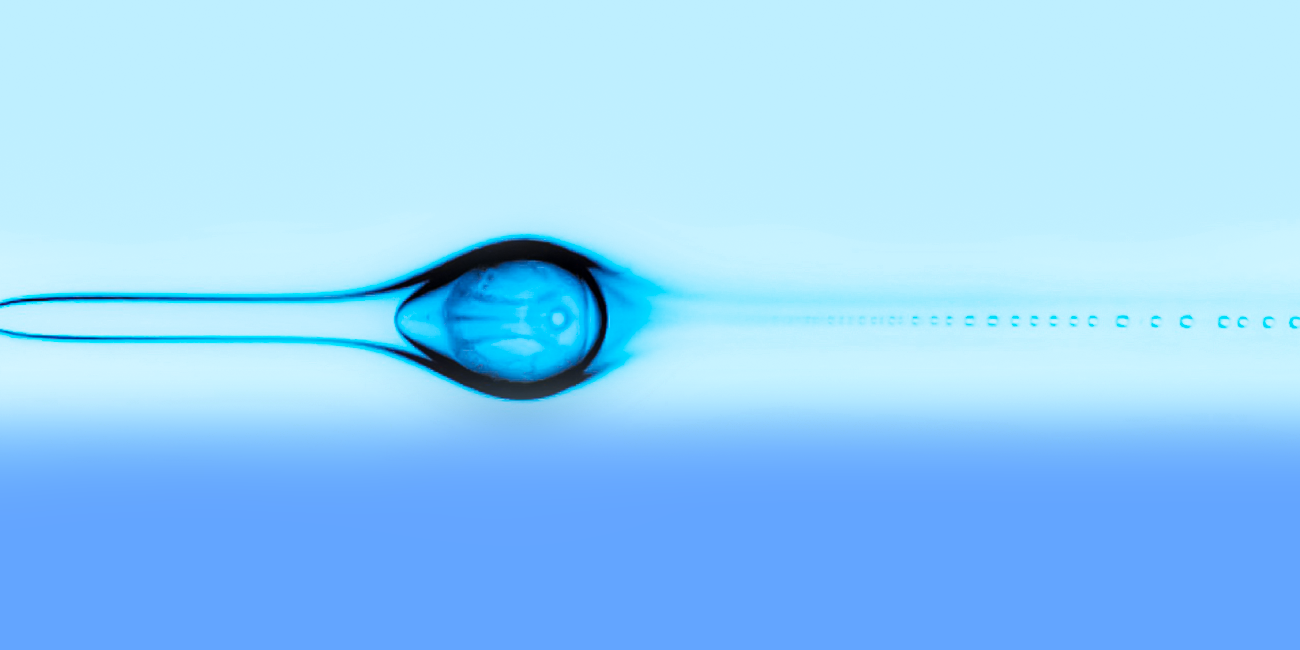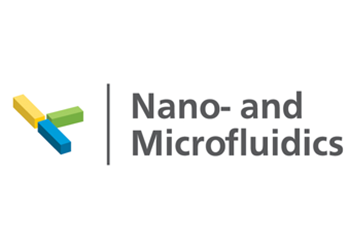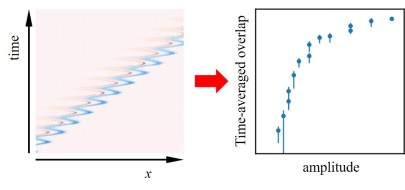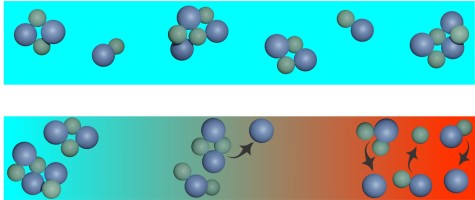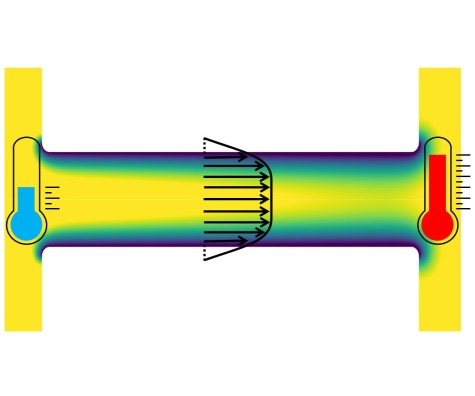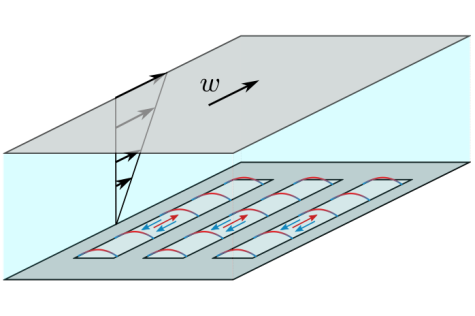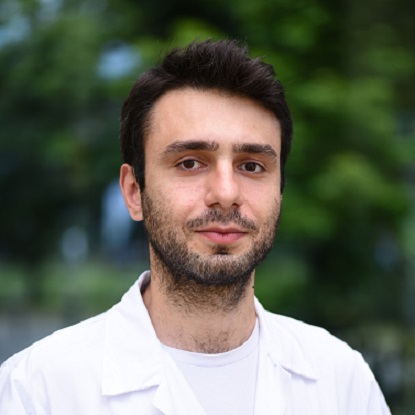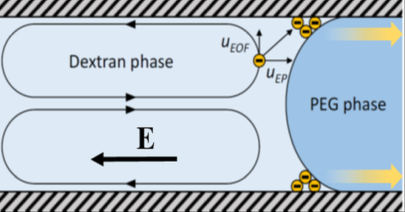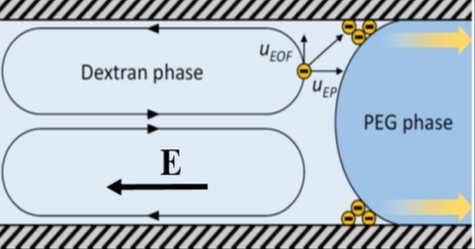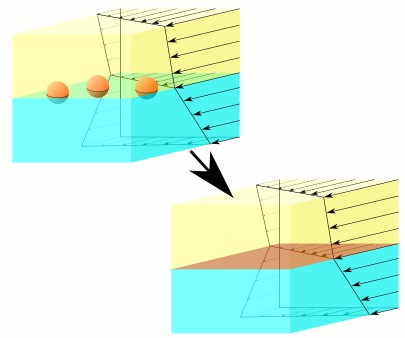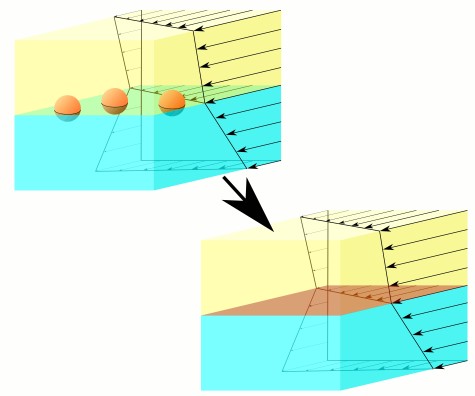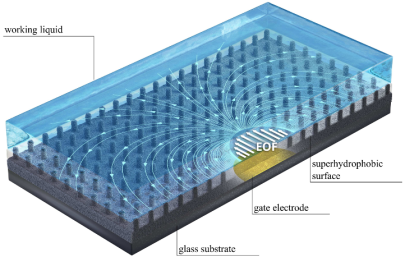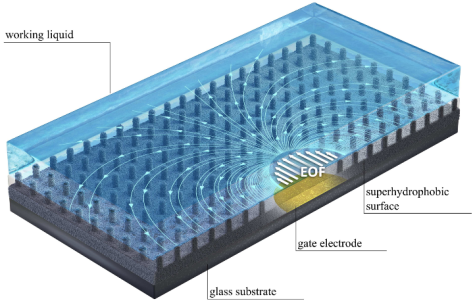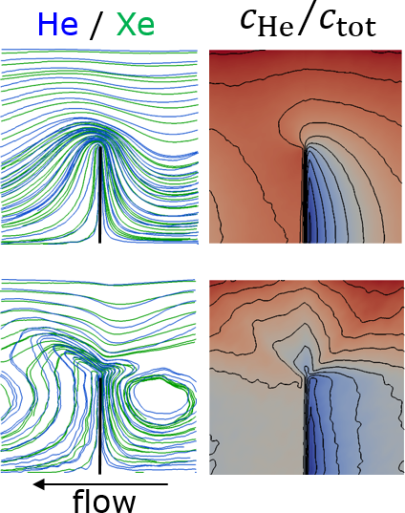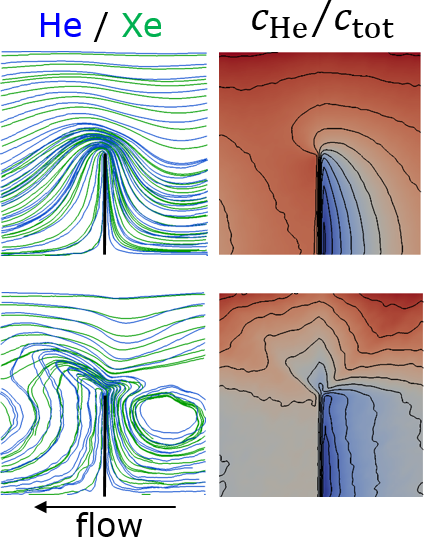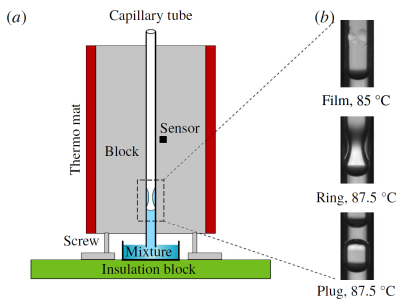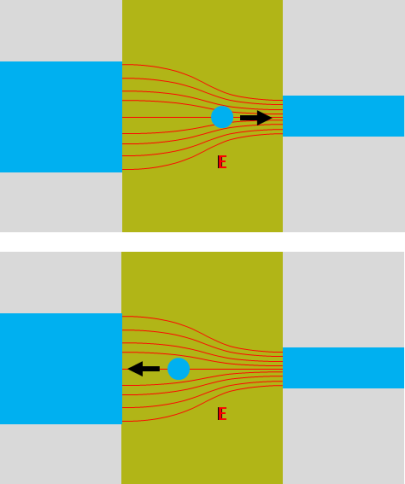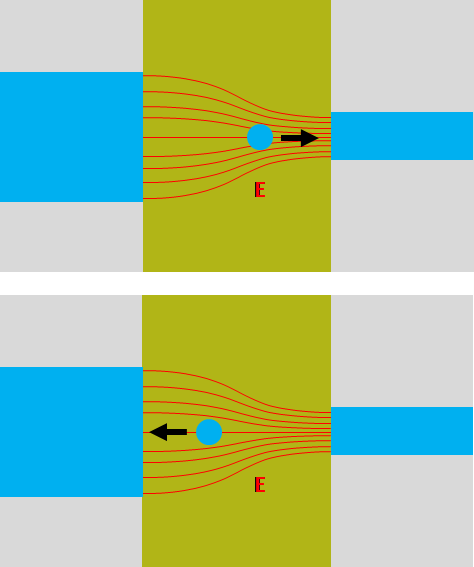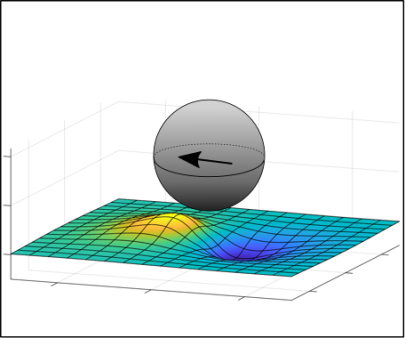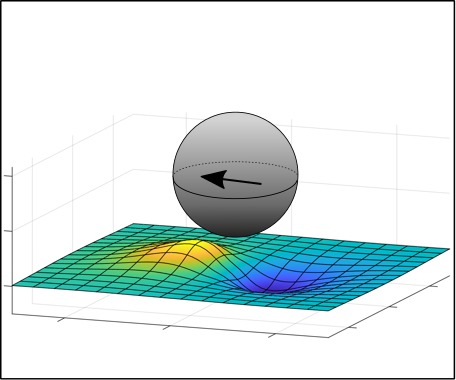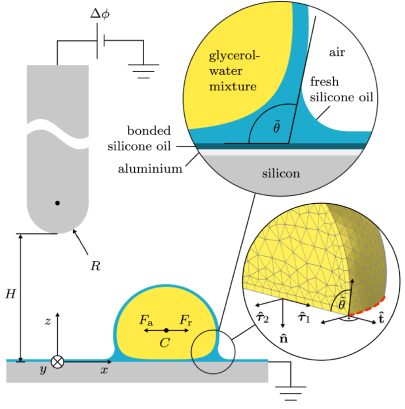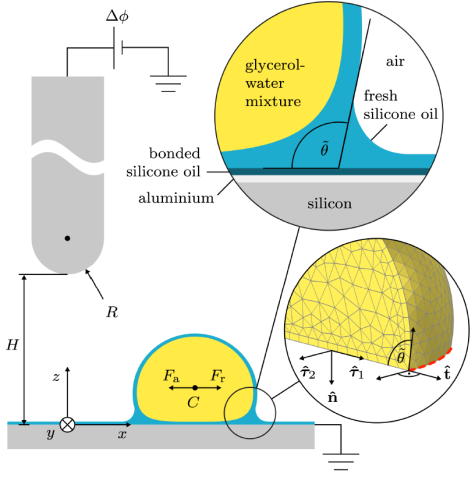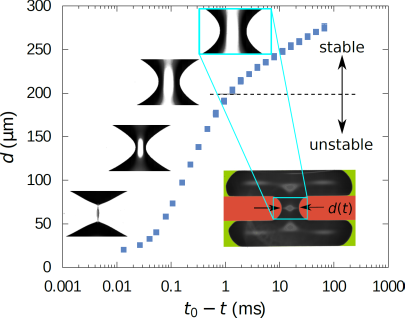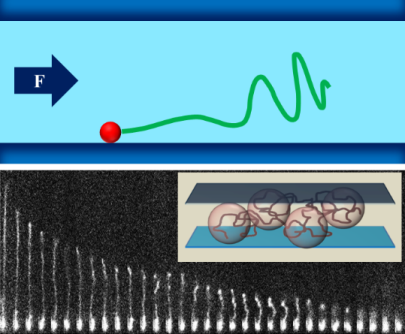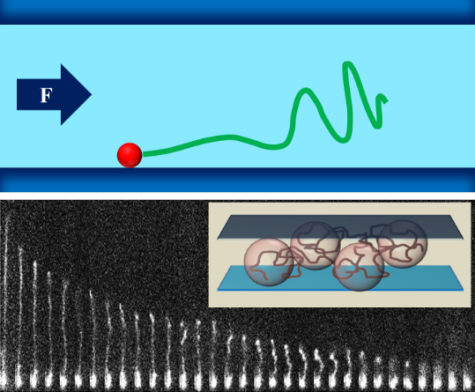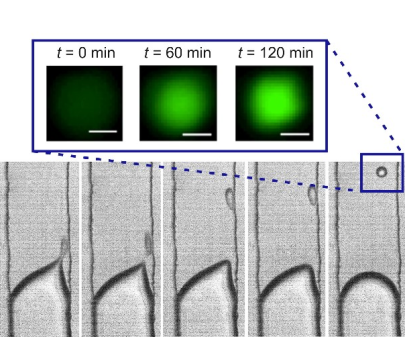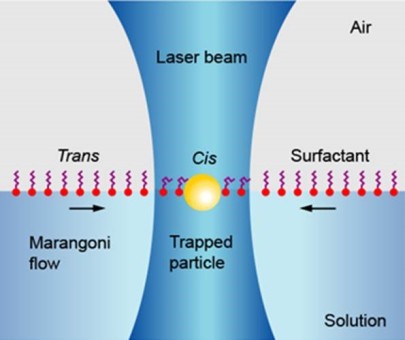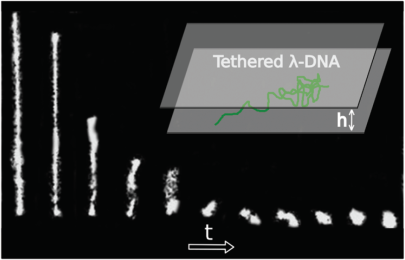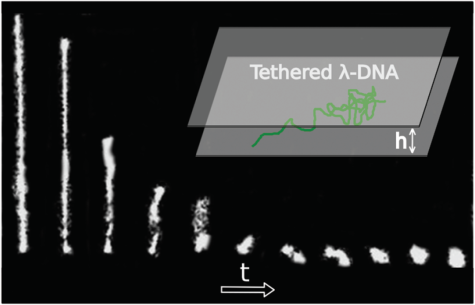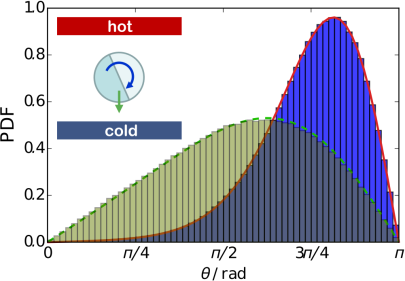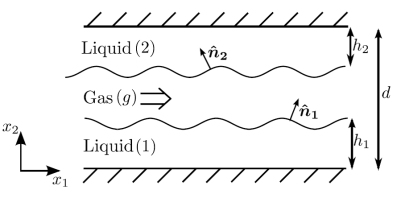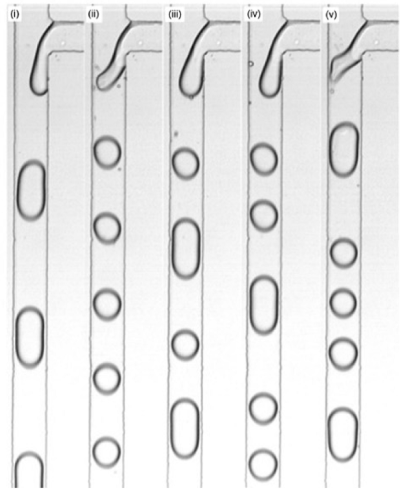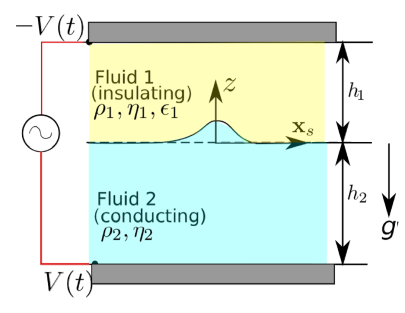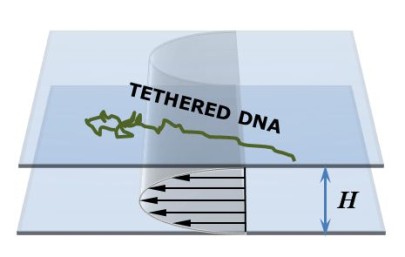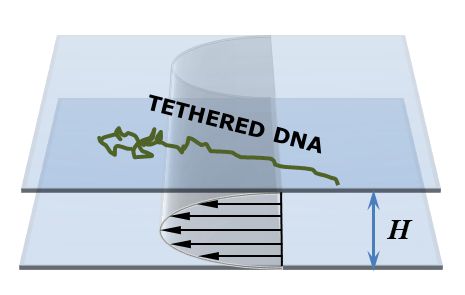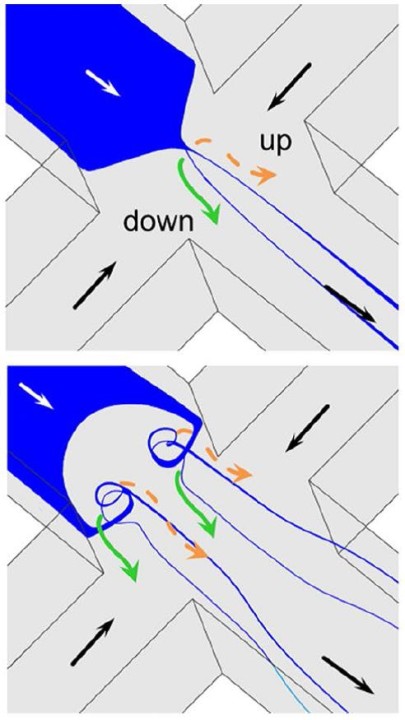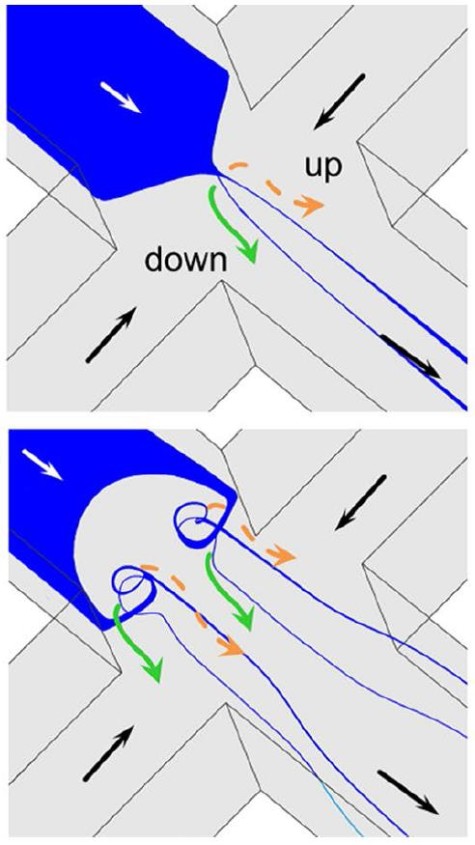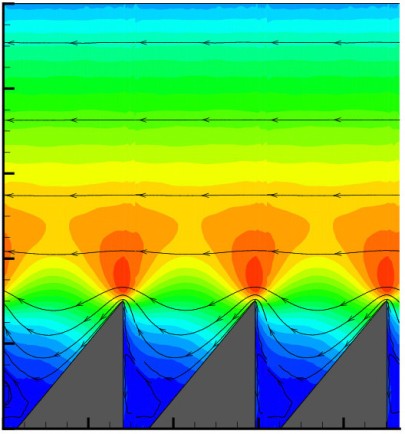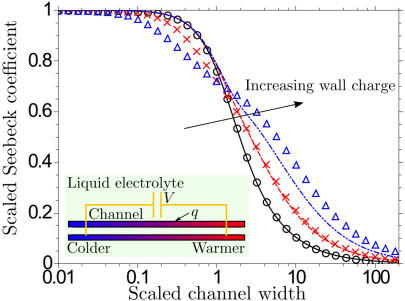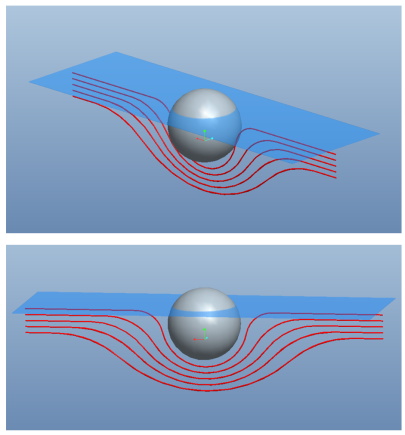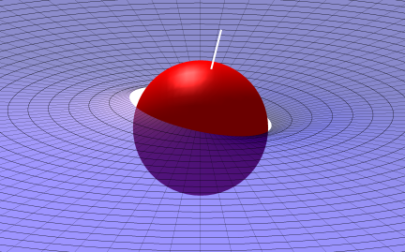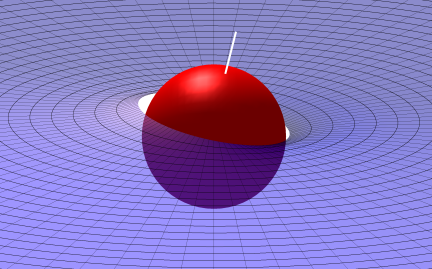June 3, 2024
How nature charges water drops
Water drops sliding on a surface get electrically charged. Known for 30 years, this effect holds potential for energy harvesting but also damages semiconductors that are repeatedly washed throughout their production. We now provide a long-missing theoretical explanation for this charge separation. Our theory uncovers why the effect is predominantly observed on water-repelling surfaces and why it surprisingly decreases at higher velocities. Our work has been highlighted in the American Physical Society’s Physics Magazine and published in Physical Review Letters.
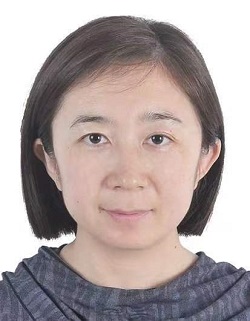
May 22, 2024
New group member: Shuyan Deng
Yesterday Shuyan Deng joined our group as a postdoctoral researcher. She will work on the modeling and simulation of microscale flow phenomena.
Welcome Shuyan!
May 7, 2024
Trapping individual nanoobjects with gate electrodes
Life is built from nanoscale biological objects. Thus, controlling their location is imperative for fundamental research and applications in the life sciences. However, Brownian motion, random spatial fluctuations of small particles due to their thermal energy, makes their precise localization difficult. One strategy to overcome this obstacle uses electrostatic interactions. Nanoparticles in aqueous solutions, as well as the walls of nanofluidic devices, are usually negatively charged and repel each other. By creating indents in the walls of nanofluidic devices, repulsion from the flat walls, as well as the indents can be used to restrict the location of nanoparticles. Together with a team at IBM Research Europe and ETH Zurich), we have shown that gate electrodes can be used to control these electrostatic interactions. The results, recently published in The Journal of Physical Chemistry Letters open routes towards real-time controllable nanoparticle traps.
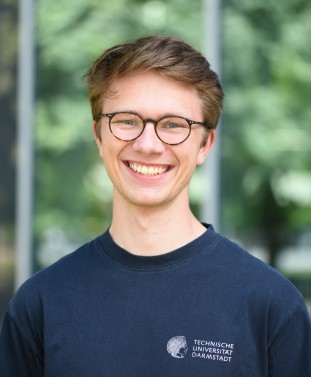
May 3, 2024
New group member: Florian Stoll
A few days ago, Florian Stoll joined our group. He will pursue his PhD and experimentally study the transport processes through liquid pores.
Welcome Florian!
March 19, 2024
Towards controlled chemical reactions between minute samples
Performing chemical reactions between minute samples is the prerequisite for a number of industrial processes, for example high-throughput screening in pharmacological research. Ideally, one would be able to perform these reactions in a very controlled manner. Among others, it is desirable to bring two reagents in contact for a well-defined time, after which the reaction is stopped and its progress is analyzed. We have developed a method that could enable such a reaction control: Two samples, separated by a narrow spacer, are transported through a microchannel by electrophoresis, where an oscillatory electric field brings the samples in contact in a time-periodic manner. The results were published in the journal Analytical Chemistry.
March 01, 2024
Transformation of heat into electricity in nanochannels
About 70% of all the energy produced from sources such as power generators, factories, and homes is lost in the form of heat and dissipated to the environment. A technology that can convert only a small percentage of this energy into electricity could become a game changer. One promising option is to use nanopores or nanochannels filled with an electrolyte for energy conversion. We have identified a new energy-conversion mechanism that produces high thermovoltages and makes use of the fact that the concentration of charge carriers in nanochannels is temperature dependent. The results were published in the journal Physical Review Letters and highlighted on the TU Darmstadt homepage.
February 29, 2024
Disorder-to-order transition of long fibers in evaporating drops
Usually the world evolves towards increasing disorder, as expressed by the second law of thermodynamics. There are, however, some remarkable exceptions, i.e. systems that self-organize in such a way that their order increases. We have discovered one such system. When a liquid drop that contains a long fiber (much longer than the drop diameter) evaporates, the fiber evolves from an initially disordered configuration to an ordered one. For example, after the liquid has evaporated, the fiber is deposited on a surface with the shape of the number 8. These results were recently published in the journal Soft Matter.

February 1, 2024
New group member: Santanu Kumar Das
Today, Santanu Kumar Das joined our group as a postdoctoral researcher. He will focus on the modeling on simulation of thermoelectric energy conversion in nanochannels.
Welcome Santanu!
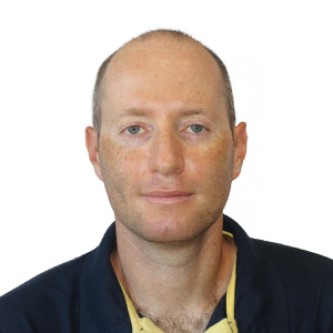
February 1, 2024
New group member: Oles Dubrovski
Today, Oles Dubrovski joined our group as a postdoctoral researcher. He will focus on the mathematical modeling of transport processes on small scales.
Welcome Oles!
December 6, 2023
High voltages in sliding drops
Water drops sliding on surfaces get electrically charged. How much? Up to several kilovolts! We demonstrate this surprising behavior in experiments. Further, we theoretically show that the reason lies in the surface potential, a fundamental property of solid-liquid-interfaces, which is electrostatically amplified in sliding drops. Our findings have strong implications for energy harvesting from sliding drops and enable a simple and inexpensive way of measuring surface potentials. These results were recently published in The Journal of Physical Chemistry Letters.
December 1, 2023
Electric charges influence wetting
Whether a liquid drop sticks to a surface or rolls off depends on contact angle hysteresis—the difference between the angles formed at the advancing and receding contact lines of a moving drop. While having been researched for a century, established theories have overlooked one essential contribution to contact angle hysteresis. We show that electric charges, spontaneously left on a surface by sliding water drops, can substantially influence contact angles through electrostatic interactions and thus hinder roll-off. The effect occurs for a wide range of surfaces and aqueous electrolytes. We explain the underlying mechanism with a quantitative theory. These results were recently published in Physical Review Letters
November 28, 2023
Prof. Hardt’s talk at ICOM2023 now online at YouTube
The talk Prof. Hardt gave at the First Indian Conference on Micro Nano Fluidics is now available at YouTube, see: www.youtube.com/watch?v=Eig9nNTVLUE

August 25, 2023
New group member: Alexander Wagner
A few days ago, Alexander Wagner joined our group. He will pursue his PhD and study wetting and optimization of grid structures.
Welcome Alexander!
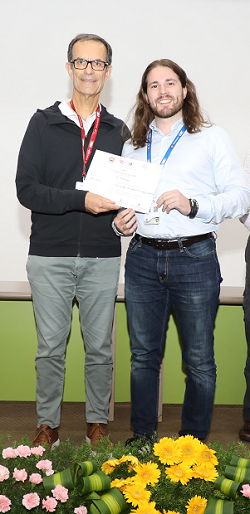
October 30, 2023
Oral presentation award for our PhD student Aaron Ratschow at ICOM2023
At the First Indian Conference on Micro Nano Fluidics, held 29th September – 1st October 2023 at IIT Madras, our PhD student Aaron Ratschow received a presentation award for his talk entitled “Gate electrodes can modulate nanofluidic potential energy landscapes”. The award was presented by Prof. Dimos Poulikakos, ETH Zurich.
Congratulations Aaron!
August 21, 2023
Efficient pumping of liquids by temperature gradients
The standard method to pump a liquid through a channel or duct is to apply a difference in pressure between the inlet and outlet, i.e. a pressure gradient. It is also known that electrolyte solutions such as water can be pumped by applying a temperature gradient, an effect that is termed “thermoosmotic flow”. However, the flow velocities that can be reached using that principle are small, which has so far prevented widespread applications. On the nanoscale, boundary slip needs to be taken into account, which means that in some cases the liquid slips along the channel walls. We were able to derive analytical expressions for the thermoosmotic flow field in slit channels with boundary slip. For channels formed by polarized graphene surfaces, we predict a velocity enhancement factor of up to 250 compared to no-slip channel walls. This may open the door to applications of thermoosmotic flow in nanofluidics. The results were recently published in JFM Rapids.

June 7, 2023
New group member: Pramodt Srinivasula
A few days ago, Pramodt Srinivasula joined our group as a postdoc. He will work on the design and simulation of microfluidic supply networks for organoids.
Welcome Pramodt!
May 22, 2023
Detection of minute molecular samples in microchannels
In the detection of minute (bio)chemical samples, electrophoretic schemes, i.e. sample transport due to electric fields, play a big role. Detecting even smallest sample amounts during electrophoretic transport is a big challenge. We have demonstrated that knowledge about the physics of electrophoretic transport can help reducing the detection limits by orders of magnitude. The data postprocessing scheme we have developed allows extracting signals from a noisy background even in cases where, based on conventional methods, no signal is discernable. These results were recently published in the journal Analytical Chemistry.
May 8, 2023
On superhydrophobic surfaces, surfactants prevent drag reduction
Theory predicts that, due to the large amount of air trapped in the grooves of a superhydrophobic surface, water can flow past it almost unimpeded. Surfactants, molecules that attach to the gas-liquid interface, can form a nearly incompressible layer at the interface, strongly affecting the flow in their vicinity. We study liquid flow over an array of narrow gas-filled grooves embedded in an otherwise planar surface, with the gas-liquid interface protruding above or below the plane. In the presence of surfactants, a recirculating flow develops at the gas-liquid interfaces, such that the drag on flow over such surfaces becomes much larger than at corresponding surfactant-free interfaces.
January 9, 2023
Individually controllable nanopumps
We have explored a novel nanopumping concept that is based on electrokinetic flow through a conical nanopore equipped with a gate electrode. In contrast to other electrokinetic nanopumps, these pumps are individually controllable. Such enhanced control of the nanoworld may prove beneficial for a number of applications, among others DNA sequencing. Our work was highlighted on the web pages of the American Physical Society (https://physics.aps.org/articles/v15/s174), where further information can be found.
December 6, 2022
When a drop transforms into a bubble
Drops impacting on surfaces have been studied intensely during the past decades. It thus came as a surprise to us when we discovered a mode of drop impact that has remained undiscovered up to now. We let water drops impact on microporous membranes through which a gas discharges, for which we identified four distinct impact modes. In the most spectacular impact mode, a drop gets in contact with the membrane surface and forms a three-phase contact line away from the center of impact. The contact line remains pinned, while the gas flow through the membrane pushes the liquid surface away from it. As a result, the drop transforms into a bubble that remains attached to the membrane. When we work with a surfactant solution instead of water, the drops transform to large long-lived bubbles.
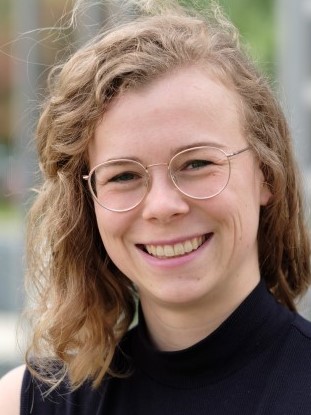
November 7, 2022
New group member: Lisa Bauer
A few days ago, Lisa Bauer joined our group. She will pursue her PhD and study dynamic behavior of fiber-laden drops.
Welcome Lisa!
October 31, 2022
Incompressible surfactants on the move
Even relatively small amounts of surfactants, molecules that attach to the interface between two fluids, can behave nearly incompressible at the interface. For liquid flowing over an elongated rectangular gas-filled cavity embedded in a planar wall, this incompressibility may render the interface immobile as long as the interface remains planar. By adjusting the gas-pressure in the cavity, the gas-liquid interface can be deflected above or below the planar wall. We find that in this case liquid flowing over the cavity sets the interface in motion, inducing a recirculating flow pattern at the interface.
Baier, Hardt, Shear flow over a surface containing a groove covered by an incompressible surfactant phase, J. Fluid Mech., 949, A34 (2022), https://doi.org/10.1017/jfm.2022.775
September 8, 2022
Tuning the wavelength of electrically induced waves
When a time-varying electric field acts on the interface between two immiscible liquids, characteristic waves form at the interface. A similar thing happens when two superposed liquids are vibrated using a shaker. These interface waves form in a self-organization process, and up to now, it was unknown how to tune their wavelength. We have found a way to exactly do that, as we show in a recently published paper: We superpose the time-varying field that drives the waves with a constant field. The results nicely agree with the predictions of a theoretical model we have developed.

September 7, 2022
New group member: Doyel Pandey
A few days ago, Dr. Doyel Pandey joined our group. She holds a PhD from the Indian Institute of Technology Kharagpur and will study thermally-induced transport processes in nanochannels, funded by a French-German co-operation project (ANR-DFG).
Welcome Doyel!
August 31, 2022
Phase transitions in evaporating drops
When a sessile aqueous drop containing different types of polymers evaporates, a demixing phase transition can occur. This means that small droplets nucleate inside the initially homogeneous polymer solution, which happens when the drop contains two polymer species that “like to stay away from each other”. During this complex phase separation process, a number of intriguing physical processes are observed. We describe and explain some of these phenomena in a recently published paper.
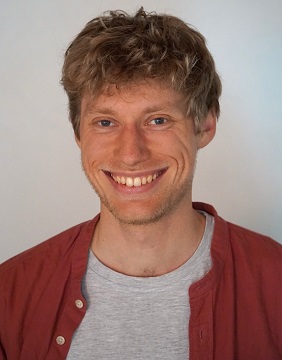
August 11, 2022
New group member: Steffen Bißwanger
A few days ago, Steffen Bißwanger joined our group. He will pursue his PhD and study channel flows of ternary liquid mixtures in which phase change occurs.
Welcome Steffen!
March 24, 2022
Electrically-induced Faraday waves
It is well-known that wave patterns (so-called Faraday waves) emerge on a vibrated liquid film. Not only mechanical forces can induce such wave patterns, but also electric forces, for example when keeping the liquid in a parallel-plate capacitor to which an AC voltage is applied. Remarkably, electrically induced Faraday waves have hardly been studied experimentally, although electric forcing offers options to control the wave patterns not available with mechanical forcing. We have studied the wave patterns of the electrically induced Faraday instability for the first time and compared them to theoretical predictions accounting for viscosity effects, with the result that there is a good agreement between experiments and theory.
January 12, 2022
Coalescence control using electric fields
Controlling the coalescence of droplets is a key requirement in microfluidics. In that context, “controlling” often means avoiding the undesired coalescence of droplets. For this purpose, usually surfactants are employed, which, however, are detrimental in a number of applications. We have shown how droplet coalescence can be suppressed without surfactants simply by placing the droplets in a homogeneous electric field. The electric field redistributes the charges in such a way that a repulsive force between two nearby droplets is created. We believe that this principle may find widespread applications in droplet microfluidics wherever surfactants need to be avoided.
January 5, 2022
From Taylor cones to surface dimples
It is well known that fluid interfaces disintegrate under sufficiently strong electric fields, leading to electrohydrodynamic tip streaming, often in form of a Taylor cone. However, when we studied the influence of a local electric field on an oil-water interface, an alternative deformation mode emerged: Here, the interface is pushed away from the electrode, and additional cone structures form at the rim of the dimple. Using experimental and numerical methods, we show that small droplets inside the oil phase play a crucial role in the dimple formation. They induce a background flow, which in turn perturbs the interface.
October 19, 2021
Partial droplet coalescence – where does it end?
When an electric field derives a water droplet to an interface between oil and water, under certain circumstances partial coalescence is observed. This means that instead of merging with the water volume, the droplet bounces back, whereupon it looses a part of its volume. The product droplet can again be driven to the oil-water interface, and the whole process can be repeated, resulting in sucessively smaller droplets. We have performed corresponding experiments with a large number of successive partial-coalescence events and could produce droplets with diameters of about 400 nm. The fact that we could not observe any smaller droplets is probably due to the optical resolution limits of our microscope. Would this process still work for droplet diameters of a few nanometers?
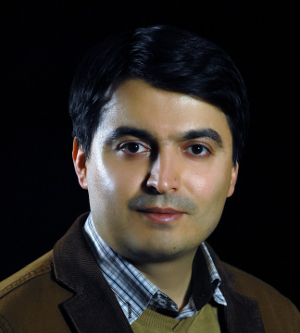
October 18,2021
New group member: Arman Sadeghi
A few days ago, Professor Arman Sadeghi joined our group. Before that, he worked as Associate Professor at the University of Kurdistan, Iran. He is funded by the Alexander von Humboldt Foundation in terms of a Humboldt Research Fellowship.
Welcome Arman!
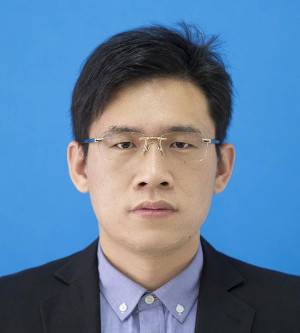
October 10, 2021
New group member: Qingwen Dai
A few days ago, Dr. Qingwen Dai joined our group. Before that, he worked as a lecturer at Nanjing University of Aeronautics & Astronautics, China. He is funded by the Alexander von Humboldt Foundation in terms of a Humboldt Research Fellowship.
Welcome Qingwen!
September 30,2021
Article published in Annual Review of Fluid Mechanics
Recently, an article entitled “Flow and Drop Transport Along Liquid-Infused Surfaces”, authored by Steffen Hardt and Glen McHale, was published in the Annual Review of Fluid Mechanics. In this article, recent developments related to liquid-infused surfaces are reviewed from a fluid mechanics perspective. It covers a spectrum ranging from single-phase flow along liquid-infused surfaces to dynamic wetting processes. A preprint of the article can be found here:
https://www.annualreviews.org/doi/abs/10.1146/annurev-fluid-030121-113156

September 21, 2021
New group member: Satarupa Dutta
A few days ago, Dr. Satarupa Dutta joined our group. She recently obtained her PhD at the Indian Institute of Technology Guwahati and will study thermoelectric energy conversion in nanochannels in the framework of the EU project TRANSLATE, together with Rajkumar Sarma.
Welcome Satarupa!
August 24, 2021
Hydrodynamic dispersion in Hele-Shaw flows
In the 1950s, Taylor and Aris published their landmark results on the spreading of a dissolved species in unidirectional flow, i.e., in a tube or a channel, referred to as Taylor-Aris dispersion. We have considered flows between parallel-plates (so-called Hele-Shaw flows), which are no longer unidirectional, but may exhibit complex patterns owing to inhomogeneous wall boundary conditions. For such scenarios, we have asked how a dissolved species may spread. We have been able to reduce the 3D advection-diffusion equation for the concentration field to a 2D dispersion equation that may be viewed as a generalization of Taylor-Aris dispersion. We believe that in the future this equation could find widespread use in simplifying simulations of hydrodynamic dispersion in microfluidics.

August 6, 2021
New group member: Rajkumar Sarma
A few days ago, Dr. Rajkumar Sarma joined our group. He recently obtained his PhD at the Indian Institute of Technology Guwahati and will study thermoelectric energy conversion in nanochannels in the framework of the EU project TRANSLATE.
Welcome Rajkumar!
June 22, 2021
Start of EU project TRANSLATE
Recently, the EU project TRANSLATE, funded under the FET-Open scheme of the EU, was launched. Heavily relying on results we published a few years ago (https://journals.aps.org/prl/abstract/10.1103/PhysRevLett.116.225901), this project aims at establishing thermoelectric energy converters based on electrolyte-filled nanochannels. This could pave the way to the widespread use of inexpensive energy conversion devices made from highly abundant materials. Apart from our group, partners from the University College Cork (Ireland), the University of Latvia and the Spanish company Cidete form the TRANSLATE team. Further information can be found here: https://www.tu-darmstadt.de/universitaet/aktuelles_meldungen/einzelansicht_320064.de.jsp
May 7, 2021
Cloaking and shielding objects in a fluid flow
Among the best-known technologies deployed by Star Trek’s starships are their invisibility-inducing cloaking devices and their shields. Together with co-operation partners from the Technion, Israel, and IBM Research Europe we have developed a cloaking/shielding device for objects in microfluidic channels/chambers instead of starships. In cloaking mode, an object leaves the fluid flow around it undisturbed, and in shielding mode, the hydrodynamic forces on an object are eliminated. This principle may find a number of applications, for example in the manipulation of soft objects such as cells. See also https://physics.aps.org/articles/v14/s57.
April 22, 2021
Breakup of a liquid bridge on a solid surface
Liquid bridges that become unstable and break up are found in numerous situations, for example when a droplet pinches off from a liquid reservoir. We have studied the breakup dynamics of water bridges wetting a hydrophobic surface using experiments and simulations. The dynamics is governed by a balance of inertial and capillary forces. We find that the liquid bridge decays into droplets in very much the same way as a free liquid bridge.
April 16, 2021
Protein separation at liquid-liquid interfaces
The separation of proteins according to specific properties such as size plays an eminent role in many processes of the biotech industry. We have recently demonstrated a new separation process for proteins in a microfluidic device. First, a protein mixture is electrophoretically transported towards a liquid-liquid interface. The interface represents a transport resistance to the proteins, such that some species adsorb at the interface more easily than others. Protein separation can be accomplished if one species crosses the interface, while the other gets adsorbed, which was demonstrated in the paper referred to below. We believe that in the future this new method of protein separation could extend the spectrum of industrial separation processes.
February 26, 2021
Stability of liquid rings in capillary tubes
Imagine introducing a small droplet into a capillary tube with circular cross section. “Small” means that the droplet volume is of the order of the tube diameter cubed or smaller. Such a droplet can exist in several shapes. It can form a liquid plug, a liquid ring or a sessile droplet at the tube wall. Interestingly, whether or not a liquid ring can exist depends on its volume and the contact angle of the liquid at the wall. We have explored the stability limits of liquid rings using analytical and numerical methods and represented the results in a stability map.
December 17, 2020
Electroosmotic flow (EOF) induced by surface acoustic waves
Surface acoustic waves (SAW) are widely used in microfluidics for transporting and mixing liquids. SAWs are acoustic waves travelling along the interface between a solid and a fluid. Up to now, the electrokinetic effects due to SAWs have remained largely unexplored. We have theoretically studied the EOF induced by SAWs and found that in small-scale channels, the EOF velocity may significantly exceed the velocity due to the acoustic field. Therefore, SAW-induced EOF may be useful as a method for pumping liquids through small scale channels.
November 19, 2020
Fluid interfaces can become solid-like
As a stream encounters an obstacle, floating debris sometimes piles up in front of the obstacle, forming a dense layer on the water surface. At a microscopic scale, surfactants, molecules attached to the interface between two fluids, can suffer the same fate, immobilizing the interface upstream of an obstacle. ‘Super-hydrophobic’ surfaces with embedded gas pockets have been suggested for reducing drag on objects moving through water. With this in mind, we investigated the impact that surfactants have on this mechanism and found that parts of the gas-water interface become ‘solidified’ by surfactant pile-up.
October 2, 2020
Also fluid interfaces can be viscous
Usually, viscosity is a quantity associated with the bulk of a fluid. If, however, small particles or surfactants are adsorbed to a gas-liquid or liquid-liquid interface, the interface itself becomes viscous. In that case, the viscosity coefficients represent the dissipation due to the presence of particles or surfactants in an average manner. We have recently derived analytical expressions for the viscosity coefficients of a particle-laden fluid interface in the limit of low particle concentrations. These results could significantly simplify simulations of two-phase flows with particle-laden interfaces.
May 29, 2020
Intermediate wetting states on superhydrophobic surfaces
Together with cooperation partners from the Technion/Israel, we have studied the wetting states of hierarchical superhydrophobic surfaces, consisting of an array of micropillars that is decorated with nanoparticles. We find a multitude of intermediate states between the classical Cassie and Wenzel states. The transition from the Cassie state to these intermediate states is partially reversible. A summary of the main results can be found here.
May 29, 2020
Enhancement of electroosmotic flow on superhydrophobic surfaces
Together with cooperation partners from the Technion/Israel, we have studied the electroosmotic flow along superhydrophobic surfaces, augmented by gate electrodes. Via the charges created at the gas-liquid interfaces, the flow velocity can be increased by more than a factor of 10 compared to unstructured surfaces. In addition, the flow is entirely pH-independent. A summary of the main results can be found here.
May 6, 2020
Gas separation in a Knudsen pump
Knudsen pumps rely on gas-flows induced by temperature differences. We have studied the transport of gas mixtures along a Knudsen pump and observed differences in flow of the individual components of the mixture. Therefore, such a pump may be used for gas separation. This kind of separation of gas species by mass or size plays an important role for many applications in chemical engineering.
March 2, 2020
“Tears of wine” in capillary tubes
“Tears of wine” is a phenomenon that can be observed in wine glasses: Driven by Marangoni stresses, a liquid film crawls up along the glass wall. Now imaging shrinking the diameter of the wine glass to one millimeter. In that case, ring-like structures are formed from the film. These liquid rings finally collapse and form plugs that are propelled along the capillary tube by evaporation. We have studied this phenomenon based on experiments and theory.
February 19, 2020
Pattern formation in layers of DNA molecules
DNA molecules can be concentrated by electrophoretic accumulation at an interface between two immiscible polymer solutions. Apart from its relevance in applications, this process goes along with the formation of characteristic DNA concentration patterns, visible in the figure at the left. We have experimentally studied the concentration patterns and formulated a theory describing the pattern formation. The theoretical predictions based on linear stability analysis compare favorably with the experimental results.
January 10, 2020
Species transfer using small droplets as carriers
Transferring chemical species or nanoparticles in a controlled way becomes challenging when very small species amounts are considered. We have found a solution to this problem, where a droplet with a diameter of the order of 5 µm serves as carrier for the cargo. The method is sketched in the schematic on the left. The droplet reciprocates between two aqueous reservoirs under the influence of a DC electric field. Upon touching the reservoir, the droplet reverses its charge and its direction of motion. We have studied the transfer of chemical species between the two reservoirs mediated by the droplet.
December 12, 2019
Nanoparticle-wall interactions in gases
A sphere moving in the vicinity of a wall experiences an increased fluid-dynamic drag force compared to motion far from solid boundaries, influencing the adsorption of particles at surfaces. For a small particle inside a gas, the fluid dynamics of such problems becomes very involved, since the Navier-Stokes equation is no longer applicable. We have computed the corresponding drag force on a particle and find that it is much lower than the one predicted by the Navier-Stokes equation.
June 7, 2019
Non-contact electrostatic manipulation of droplets on liquid-infused surfaces
Liquid-infused surfaces have unique liquid-repelling properties. In comparison with conventional superhydrophobic surfaces, liquid-infused surfaces provide stable wetting states and pronounced self-healing properties. We have established the manipulation of highly mobile droplets sitting on silicone-oil infused surfaces by exploiting a non-uniform electric field between a grounded substrate and a non-touching pin electrode placed above it. Droplets are attracted towards the pin electrode, and translational velocities can exceed 1 cm/s.
May 8, 2019
Evaporation of droplets on surfaces with wettability patterns
On a surface with hydrophilic and hydrophobic stripes, an evaporating droplet breaks up if the wettability contrast between the different regions is high enough. A liquid bridge forms on the hydrophobic stripe, and when the width of the bridge reaches a critical value, it becomes unstable and breaks up rapidly. We have studied this process based on experiments, numerical simulations, and a heuristic analytical model.
March 13, 2019
Review article on surface-tethered polymers in confinement
In a number of microfluidic applications, polymers are tethered to the microchannel walls. Even in situations where the channel diameter is significantly larger than the radius of gyration of the polymer, confinement effects can become important. Our recent review article gives an overview of the research results in this area.
March 6, 2019
On-demand production of femtoliter droplets in microchannels
We have developed a method to produce monodisperse droplets inside microchannels with volumes in the femtoliter range on demand. The method utilizes pulsed electric fields deforming the interface between an aqueous and an oil phase and pinching off droplets. It can be applied even to solutions with a zero-shear rate viscosity more than ten thousand-fold higher than that of water. The droplets may serve as biological reaction compartments.
Controlling the trajectories of nano/micro particles using light-actuated Marangoni flow
The ability to manipulate small objects and to produce patterns on the nano- and microscale is of great importance, both with respect to fundamentals and technological applications. The manipulation of particles with diameters of the order of 100 nm or below is a challenge because of their Brownian motion but also because of the scaling behavior of methods such as optical trapping. We have developed a method enabling the trapping and manipulation of nano- and microparticles based on interfacial flows controlled by visible light. The inherent advantages of this method are the linear scaling of the trapping force with the particle diameter and the fact that the force is less dependent on particle properties than in the case of conventional methods.
October 22, 2018
Electrophoresis of surface particles
The electrophoresis of particles immersed in a liquid is a well-studied phenomenon. However, what happens when a particle attached to a liquid surface translates along that surface driven by an electric field has been largely unknown. We have computed the electrophoretic mobility of a particle at the interface between two fluids with large viscosity contrast. For thin Debye layers, the Smoluchowki mobility is recovered. Generally, the mobility depends on the contact angle between the fluids and the particle. We have also calculated the interfacial deformation caused by Debye layer around the particle.
October 8, 2018
Relaxation of surface-tethered polymers under moderate confinement
When long-chain polymers attached to a surface become stretched and the stretching force is released, they relax back to their coiled state within a characteristic time, denoted the relaxation time. We have shown that the polymers “feel” the presence of a second wall even if the distance between the two walls h is significantly larger than the radius of gyration of the polymers. As a result, the relaxation time increases. These results are relevant for microchannel flows where the channel walls are decorated with polymers.
October 1, 2018
Stability of holes in liquid films
If you spill liquid over a surface, it forms a film with a thickness of the order of its capillary length. If the surface is bounded and you did not spill enough liquid, a hole will form. The stability of the hole depends on its size. There is a threshold size below which it collapses. For a water film, the collapse is dominated by inertia. We studied the stability and collapse of holes in liquid films in detail and compared the experimental results with mathematical models and simulations.
September 21, 2018
Thermophoresis of Janus particles at large Knudsen numbers
Thermophoresis, the motion of a particle along a thermal gradient, is exploited for deposition of aerosols on cooled surfaces. For non-symmetric particles it may be desirable to induce deposition with a preferred orientation of the particle. As a model system for this situation, we consider a spherical Janus particle having dissimilar reflective properties for gas molecules on its opposite hemispheres and investigate the interplay between rotational diffusion and thermophoretic motion on the orientation of the particle.
August 15, 2018
Instabilities in microchannel gas-liquid flow
In a parallel-plates microchannel where the walls are coated with liquid films, separated by a gas layer in the middle, the gas flow triggers characteristic instabilities of the films. Interestingly, the instability patterns become synchronized between the two films, i.e. the upper film “knows” what the lower film does. For example, in many cases the mirror-symmetric mode (with respect to x2, see the figure) dominates. We have performed a detailed analysis of the coupled instability modes.
May 14, 2018
Individual droplet size control in a microfluidic T-junction droplet generator
Electric fields can be used to control the size of individual aqueous droplets produced at a microfluidic T-junction. Under a sufficiently strong electric field, the droplet diameter is about half of the diameter obtained without electric field. Using electric field pulses with a duration of the order of the inverse droplet production frequency, the size control of individual droplets produced in a continuous stream becomes possible. Based on that, arbitrary droplet size sequences can be encoded.
December 11, 2017
Excitation of fluid interfaces with AC electric fields
An interface between a dielectric and a conducting fluid can be excited using an AC electric field. When the electric field strength exceeds a threshold voltage, patterns with a characteristic wavelength appear at the fluid interface. Different from the Faraday instability, a related case where the interface becomes unstable due to a periodic acceleration, the response of the system is very complex when excited by a superposition of different frequencies. We have analyzed the instability modes using Floquet theory. Corresponding instabilities may be utilized for pattern formation based on self-organization.
August 17, 2017
Stretching of confined surface-tethered polymers in pressure-driven flow
Knowledge on the stretching and conformations of linear long-chain polymers in micro-confinement is of prime importance for applications such as functional surfaces with grafted polymer brushes or sequencing of DNA molecules. We experimentally characterized the stretching and conformational changes of surface-anchored long-chain double-stranded DNA molecules between parallel surfaces under pressure-driven flow. One main result is that the fractional extension of the molecules is a unique function of the product of the wall shear stress and the molecular contour length, with a weak influence of confinement. The experimental results are corroborated by a simple scaling analysis and coarse-grained lattice-Boltzmann / molecular dynamics simulations:
August 15, 2017
Some surprises in flow focusing
Flow focusing is a widely applied scheme in microfluidics, employed for creating a single-file stream of particles/cells or for creating small droplets in a two-phase flow. When the flow rate of the central stream is reduced to very small values, flow patterns very different from the common flow-focusing scenario emerge. In that case, instead of one single focused stream, two or four streams are created. The corresponding flow patterns are illustrated in the figure on the left. In the future, such flow-focusing patterns may be exploited for inertial particle sorting, among others.

April 10, 2017
Fulbright Fellow Professor Prashanta Dutta
Prof. Prashanta Dutta (http://www.mme.wsu.edu/people/faculty/faculty.html?duttaP) has come to the TU Darmstadt with a Fulbright grant from the United States (US) government to collaborate with researchers at the Institute for Nano- and Microfluidics on electric field driven transport in micro- and nanodevices. The Fulbright program is the flagship international educational exchange initiative sponsored by the United State government and the primary goal of his visit is to develop a long-term collaborative relationship between US and German researchers in the micro/nano/biofluidics area.
January 27, 2017
Knudsen pump inducing gas flow normal to temperature gradient
Knudsen pumps transport gas by exploiting temperature variations imposed by the channel boundaries, offering the advantage of not containing any moving parts. We analyzed a Knudsen pump with a temperature field generated by an applied temperature difference between the channel walls, where the ratchet-shaped wall is equipped with varying reflection properties on different sections. The figure shows streamlines and velocity magnitudes within a channel bounded by triangular teeth which are half-specularly and half-diffusely reflecting. The use of specularly reflecting patches massively increases the mass flux compared to diffusely reflecting walls.
Reference: V. Shahabi, T. Baier, E. Roohi and S. Hardt, Thermally induced gas flows in ratchet channels with diffuse and specular boundaries, Scientific Reports 7, 41412 (2017); doi:10.1038/srep41412; www.nature.com/articles/srep41412

January 02, 2017
Humboldt Fellow Dr. Aditya Bandopadhyay
On Jan 2, 2017, Dr. Aditya Bandopadhyay has joined our group as a Humboldt postdoctoral fellow. His research interests are electrokinetics, electrohydrodynamics and reactive mixing. Prior to his arrival in Germany, he has completed his education from IIT Kharagpur, India and has undertaken postdoctoral research in Geosciences Rennes, France. We look forward to a productive research collaboration.

Sept 15, 2016
Humboldt Fellow Professor Dominik Barz
On Sept 1, 2016, Professor Dominik Barz of Queen’s University/Canada joined our group. He is supported by the Humboldt Foundation and pursues a research program in the field of electrokinetic flows. We are looking forward to a fruitful co-operation.
July 4, 2016
GIF Research Grant
We have won a research grant by the German Israeli Foundation (GIF). Together with Dr. Moran Bercovici from the Israel Institute of Technology we will study methods for tailoring and reconfiguring complex electroosmotic flow patterns in a channel-free microfluidic device.
June 3, 2016
Thermoelectricity in confined liquid electrolytes
The electric field induced in a bulk phase of a liquid electrolyte exposed to a temperature gradient is attributed to different thermophoretic mobilities of the dissolved ion species. We have shown that such Soret-type ion thermodiffusion is not required to induce thermoelectricity even in the simplest electrolyte if it is confined between walls carrying a charge density. The space charge of the electric double layer leads to selective ion diffusion driven by a temperature-dependent electrophoretic ion mobility, which —for narrow channels— may cause thermovoltages larger in magnitude than for the classical Soret effect. On the left, the corresponding (scaled) Seebeck coefficient is plotted for different values of the surface charge density against the (scaled) channel width.
February 19, 2016
Stokes drag on a sphere translating along a fluid-fluid interface
Presumably the most well-known achievement of George Gabriel Stokes is his formula for the drag force experienced by a sphere translating in an unbounded fluid at low Reynolds numbers. However, in some scenarios small particles are attached to an interface between two immiscible fluids, constrained to tangential motion relative to the interface. We have analyzed this situation and derived a generalization of Stokes’ law for large viscosity contrast and small capillary number. The image at the left is a sketch of the corresponding streamlines.
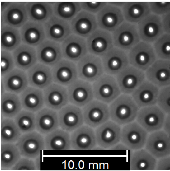
October 26, 2015
Structuring thin liquid films utilizing the Bénard-Marangoni instability
If a system of two superposed liquid films is exposed to a temperature gradient normal to the films, the upper layer exhibits convection cells which deform the lower thin film in an identical pattern. This effect can be seen in the figure above, which displays the hexagonal convection cells and the humps of the thin film below. The principle could find applications in fabricating regular, highly ordered surface structures.
July 01, 2015
Institute for Nano- and Microfluidics participates in LOEWE Cluster CompuGene
Yesterday the government of the federal state of Hessen approved approx. 4.4 million Euros funding for the LOEWE Cluster CompuGene. CompuGene will focus on the development of artificial genetic circuits which may be employed for various purposes, for example for the production of certain rare substances. We will contribute by exploring microfluidic methods for studying genetic circuits in a scenario as close as possible to in vivo conditions.
April 07, 2015
Results on motion of a microsphere along a fluid interface published in Journal of Fluid Mechanics
A microsphere driven along an interface between two fluids of highly different viscosities experiences a drag force differing from the well-known Stokes drag. Additionally, the viscous flow around the moving particle deforms the fluid-fluid interface from its equilibrium shape while the particle assumes a tilted orientation. The figure below depicts a spherical particle with a pinned three-phase contact line moving from left to right with the lower fluid having higher viscosity than the upper. The corresponding deformation of the fluid interface results in a pair interaction between particles.

